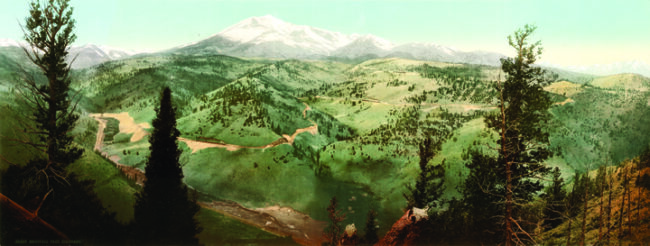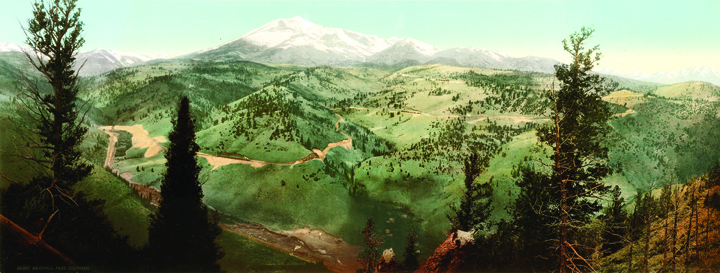By Mike Rosso
Our cover photo this month is a single panel from a panoramic shot of Marshall Pass, taken between 1890-1900 by renowned photographer William Henry Jackson, a partner with the Detroit Photographic Co. The original print was 8 1/2 x 22 inches and is labeled as a Photochrom, a process for producing colorized images from black-and-white photographic negatives via the direct photographic transfer of a negative onto lithographic printing plates.
The process was invented in the 1880s by Hans Jakob Schmid. According to Wikipedia, he was an employee of the Swiss company Orell Gessner Füssli, who founded the stock company Photochrom Zürich.
 The Detroit Photographic Co. licensed the process in the U.S. in the mid 1890s. “A tablet of lithographic limestone called a ‘litho stone’ was coated with a light-sensitive surface composed of a thin layer of purified bitumen dissolved in benzene. A reversed halftone negative was then pressed against the coating and exposed to daylight (ten to thirty minutes in summer, up to several hours in winter), causing the bitumen to harden in proportion to the amount of light passing through each portion of the negative. Then a solvent such as turpentine was applied to remove the unhardened bitumen and retouch the tonal scale, strengthening or softening tones as required. Thus the image became imprinted on the stone in bitumen. Each tint was applied using a separate stone that bore the appropriate retouched image. The finished print was produced using at least six, but more commonly ten to fifteen, tint stones.” (source: Wikipedia).
The Detroit Photographic Co. licensed the process in the U.S. in the mid 1890s. “A tablet of lithographic limestone called a ‘litho stone’ was coated with a light-sensitive surface composed of a thin layer of purified bitumen dissolved in benzene. A reversed halftone negative was then pressed against the coating and exposed to daylight (ten to thirty minutes in summer, up to several hours in winter), causing the bitumen to harden in proportion to the amount of light passing through each portion of the negative. Then a solvent such as turpentine was applied to remove the unhardened bitumen and retouch the tonal scale, strengthening or softening tones as required. Thus the image became imprinted on the stone in bitumen. Each tint was applied using a separate stone that bore the appropriate retouched image. The finished print was produced using at least six, but more commonly ten to fifteen, tint stones.” (source: Wikipedia).
Early panoramic photographs were created by stitching together multiple photos taken with glass film plates. In 1888, flexible film was invented and dozens of panoramic cameras were introduced, such as the Cylindrograph survey camera and the Wonder Panoramic. The Marshall Pass photo, seen in its entirety on pages 8 and 9, appears not to have any seams, and was likely shot on flexible film using a wide field lens. It is also possible the photo was taken with a large format camera such as an 8 x 10, using a glass plate, and cropped at the top and bottom to appear as panorama. A closer look at the photo reveals four individual narrow-gauge trains at various points along the pass, as well as the Shirley town site. Jackson died on June 30, 1942, at the age of 99. Photo is courtesy of the Denver Public Library.


